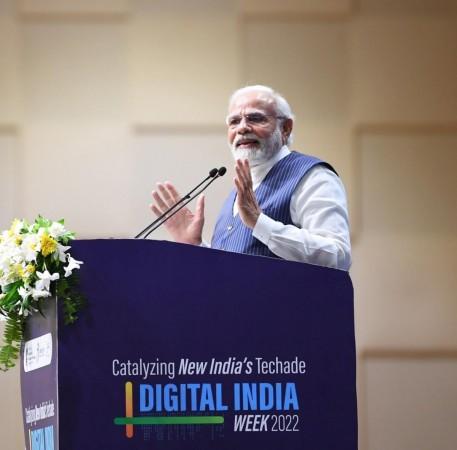
As India approaches its 79th Independence Day, the nation is witnessing a remarkable digital transformation that has reshaped its governance and service delivery systems. Initiated in 2015, the Digital India initiative has been pivotal in turning India into a digitally empowered society and knowledge economy. Central to this transformation are Digital Public Infrastructure (DPI) platforms like Aadhaar, UPI, and DigiLocker, which have revolutionized service delivery across the country. Aadhaar, the world's largest biometric identification system, has streamlined processes in banking, telecommunications, and other sectors through simplified verification processes. As of 2024, over 1.3 billion Aadhaar cards have been issued, underscoring its widespread adoption and impact.
The Unified Payments Interface (UPI) has been another game-changer, facilitating seamless digital transactions. In the last month alone, UPI recorded approximately 19.5 billion transactions worth over Rs 25 lakh crore, translating to around 650 million transactions per day. This remarkable growth in digital payments has been driven by increased internet penetration and the adoption of digital payment platforms by consumers and businesses alike. The government's decision to waive the Merchant Discount Rate (MDR) on RuPay debit cards and BHIM-UPI transactions in December 2019 further accelerated this growth, although discussions are ongoing about reintroducing MDR to sustain the platform's expansion.
India's pioneering implementation of Direct Benefit Transfer (DBT) at scale has significantly reduced corruption and ensured the timely delivery of welfare benefits. This system has been instrumental in cleaning up beneficiary databases, with over 5.87 crore ineligible ration card holders removed and 4.23 crore duplicate or fake LPG connections canceled. The success of DBT has made India's welfare system more targeted and transparent, drawing international interest in its model.
AI and E-Governance
The integration of artificial intelligence (AI) in governance has further enhanced service delivery by tailoring services to citizen needs. AI-driven tools have been employed in grievance redressal systems and predictive analytics in healthcare and agriculture, improving efficiency and outcomes. The IndiaAI Mission, a government program, has established 'AI Kosh', a data repository with over 400 databases to support researchers and entrepreneurs in developing multilingual AI solutions.
E-governance platforms have played a crucial role in reducing bureaucratic opacity and increasing public trust. The UMANG (Unified Mobile Application for New-age Governance) platform provides access to over 1,200 Central and state government services in multiple languages, including Aadhaar, DigiLocker, Bharat Bill Payment System, PAN, and EPFO. This has made government services more accessible and user-friendly, particularly for marginalized communities.
The MyGov.in platform, National AI Portal (INDIAai), and Chic-CAD Plus are noteworthy government-led programs that have contributed to citizen empowerment and inclusive development. The POSHAN Tracker, a mobile-based application for Anganwadi workers, provides real-time data on the delivery of nutrition and childcare services, ensuring better outcomes for children and mothers.
In the education sector, the Digital Infrastructure for Knowledge Sharing (DIKSHA) platform has emerged as a national platform for school education, offering resources and tools for teachers and students. The AYUSH Information Hub (AIH) provides accurate and verified information on traditional medical systems, promoting awareness and adoption of alternative healthcare practices.
The Common Services Centre (CSC) program, a Government of India initiative, has enabled easy access to public services, especially for rural citizens. Operated by Village Level Entrepreneurs (VLEs), CSCs serve as digital access points delivering a wide range of services, including banking, insurance, education, and telemedicine. As of January 2025, 5.97 lakh CSCs are operational across the country, with 4.73 lakh functioning at the Gram Panchayat level, symbolizing grassroots digital empowerment.
India's digital transformation has also extended to the telecommunications sector, with total telephone connections growing from 93.3 crores in March 2014 to over 120 crores in April 2025. Internet connections have surged from 25.15 crore in March 2014 to 96.96 crore in June 2024, registering a growth of 285.53%. This expansion has been crucial in bringing financial services closer to people, particularly in rural and remote areas.
The government's commitment to fostering innovation and entrepreneurship is evident in initiatives like the Atal Innovation Mission (AIM), which promotes a culture of innovation across the country. AIM has established 10,000 Atal Tinkering Labs in schools and incubated over 3,500 startups, creating more than 32,000 jobs in the ecosystem.
India's digital journey is not just about technological advancements but also about creating a more inclusive and equitable society. The government's focus on developing AI-driven tools and multilingual platforms ensures that services reach marginalized communities, bridging the digital divide. Prime Minister Narendra Modi has reiterated India's willingness to share its technology, knowledge, and expertise in tech-enabled governance with the Global South, positioning the country as a leader in digital diplomacy.

















